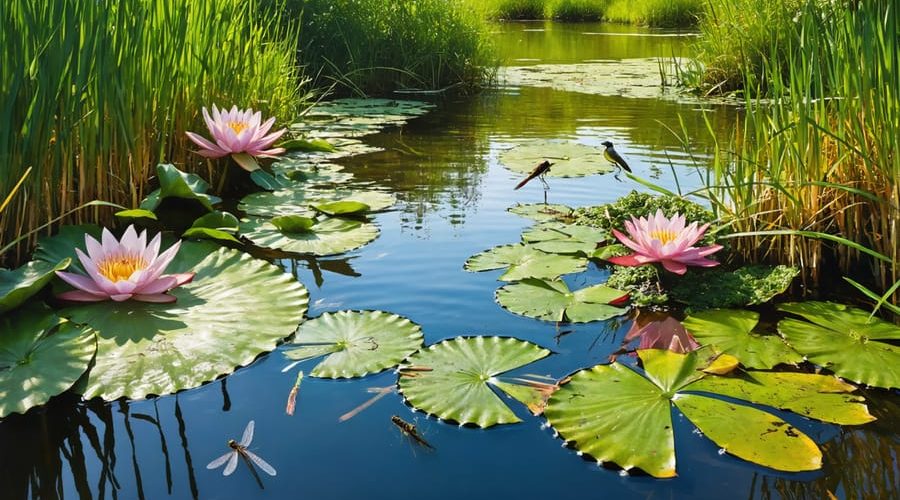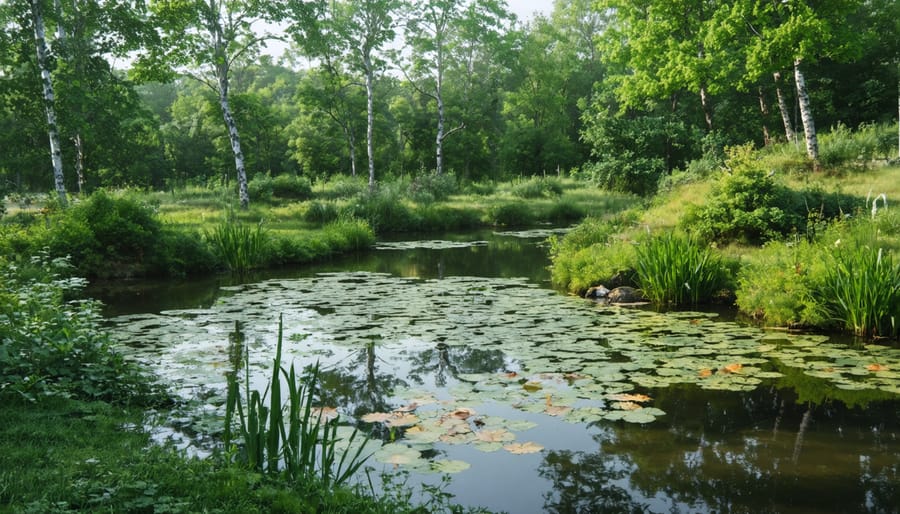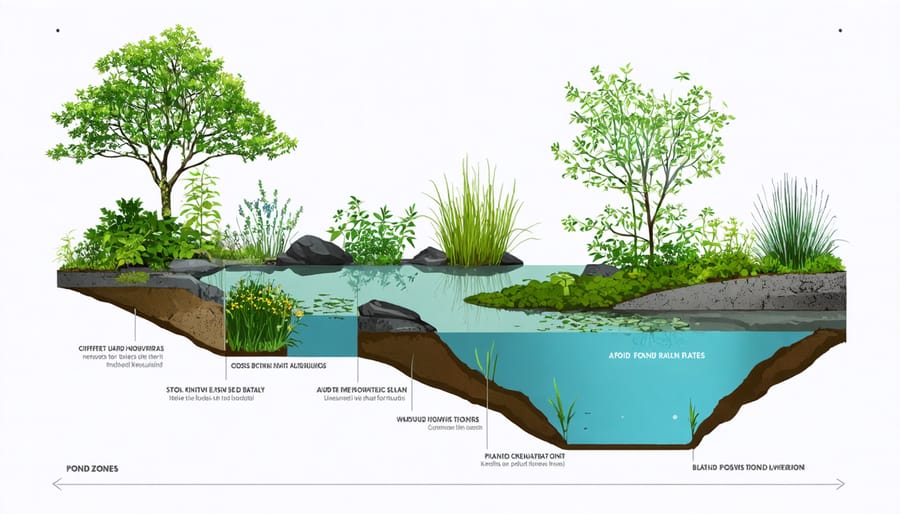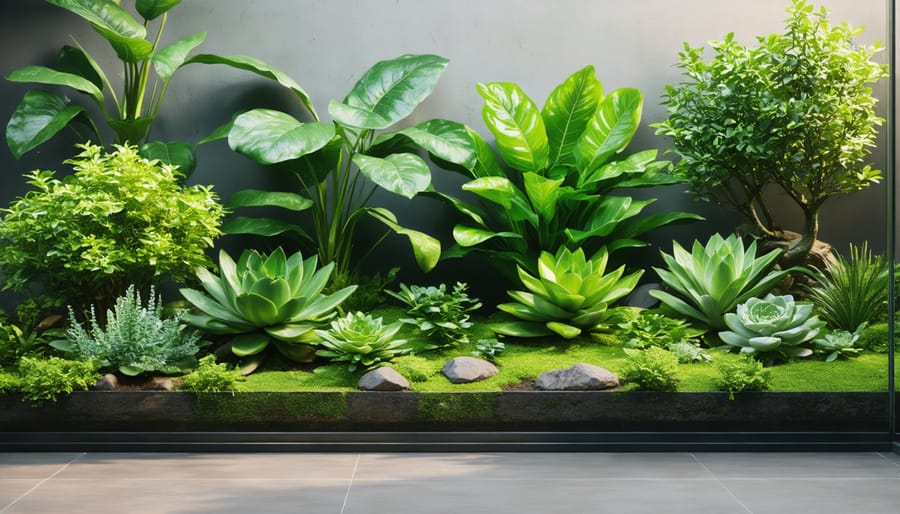
Transform Your Pond into a Thriving Native Plant Paradise
Transform your pond into a thriving aquatic ecosystem by strategically incorporating native pond plants across three distinct zones: shallow margins, deep water, and floating surfaces. Position emergent plants like rushes and sedges along the pond’s edge to naturally filter water and prevent bank erosion. Add submerged oxygenating plants such as hornwort or water milfoil to maintain crystal-clear water and provide essential habitat for fish and beneficial microorganisms. Float water lilies and duckweed on the surface to regulate water temperature and reduce algae growth by limiting sunlight penetration.
Create depth variation within your pond to support diverse plant communities, maintaining shallow shelves at 6-12 inches for marginal plants and deeper zones of 2-4 feet for underwater vegetation. This natural layering mirrors wild pond ecosystems, attracting wildlife while maintaining optimal water quality through biological filtration.
Achieve year-round visual interest by selecting plants with different blooming periods, foliage textures, and growth habits. Choose hardy species adapted to your local climate, ensuring sustainable growth with minimal maintenance requirements.
Why Native Plants Make Your Pond Better
Natural Filtration and Water Quality
Native plants in your pond do much more than just look pretty – they’re natural water purifiers working around the clock! These aquatic superheroes absorb excess nutrients like nitrogen and phosphorus that would otherwise feed unwanted algae. Through their roots, stems, and leaves, pond plants filter out debris and provide shelter for beneficial bacteria that break down waste.
Submerged plants like hornwort and water milfoil are particularly effective at oxygenating the water through photosynthesis, creating a healthier environment for fish and other pond life. Floating plants such as water lilies help shade the water, naturally controlling water temperature and reducing algae growth by limiting sunlight penetration.
The root systems of marginal plants act as natural filters, trapping sediment and preventing erosion around pond edges. These plants also uptake heavy metals and other pollutants, effectively cleaning the water without any mechanical intervention. When properly balanced, a pond’s plant life creates a self-sustaining ecosystem that maintains crystal-clear water with minimal maintenance required from you.
Remember, a diverse mix of native plants will create the most effective natural filtration system for your pond.
Wildlife Habitat Creation
Native plants play a crucial role in creating a thriving wildlife habitat around your pond. By incorporating local species, you can naturally increase pond biodiversity and create a welcoming environment for various creatures. Dragonflies, frogs, and beneficial insects are drawn to native marginal plants, where they find shelter and breeding grounds.
Water lilies and floating plants provide essential cover for fish, while submerged vegetation offers safe spaces for tadpoles and small aquatic insects. Birds are particularly attracted to seed-bearing plants and those that support insect populations. They’ll visit your pond not just for drinking and bathing but also for feeding on the insects that make your pond their home.
Consider creating different planting zones around your pond, from deep water to boggy areas. This variety of habitats supports different wildlife species throughout the seasons. Native rushes and sedges are excellent choices for pond edges, providing nesting materials for birds and shelter for small mammals. Remember, a wildlife-friendly pond doesn’t need to look wild – you can create an attractive, balanced ecosystem that’s both beautiful and beneficial for local wildlife.


Choosing the Right Native Plants
Marginal Plants
Marginal plants are essential elements of any thriving wildlife pond habitat, growing in the shallow edges and transitional zones where water meets land. These plants not only create a natural-looking border but also provide crucial benefits for your pond ecosystem.
Popular marginal plants include iris, rush, and sedge varieties, which thrive in water depths between 0-6 inches. The cattail, with its distinctive brown spikes, adds vertical interest while helping to filter excess nutrients from the water. For colorful blooms, consider marsh marigolds, which produce cheerful yellow flowers in spring, or purple loosestrife for summer color.
When planting marginals, use specially designed aquatic baskets filled with aquatic soil to prevent them from spreading too aggressively. Position taller varieties at the back of your pond, with shorter species in front to create a pleasing layered effect. Some marginals, like water mint and sweet flag, release pleasant fragrances when brushed against, adding another sensory dimension to your pond experience.
These plants also provide valuable shelter for pond wildlife, including frogs, newts, and beneficial insects. For best results, plant in spring when growth is vigorous, and remember to trim back dead foliage in late autumn to prevent excess organic matter from falling into the water.
Floating Plants
Floating plants add a natural, dynamic layer to your pond while providing essential benefits for the ecosystem. These plants drift freely on the water’s surface, creating beautiful patterns that shift with the breeze and offering valuable shade for fish below.
Popular native floating plants include water lilies, which showcase stunning blooms throughout summer, and duckweed, nature’s smallest flowering plant that forms a carpet-like cover. American frogbit, with its heart-shaped leaves and delicate white flowers, makes an excellent choice for smaller ponds, while water hyacinth impresses with its lavender blooms and naturally filtering root system.
These surface-dwelling plants play crucial roles in maintaining pond health. They help reduce algae growth by limiting sunlight penetration and compete with algae for nutrients. Their extensive root systems provide shelter for fish fry and beneficial insects, while their coverage offers protection from predatory birds.
When adding floating plants, start by covering about 40-60% of your pond’s surface. This coverage allows enough light for submerged plants while maintaining proper oxygen exchange. During summer, you might need to thin out fast-growing species like duckweed to prevent overcrowding.
For the best results, introduce floating plants in spring after the last frost. Most native species are hardy and require minimal maintenance – simply remove yellowing leaves and divide spreading plants occasionally to maintain desired coverage.
Submerged Plants
Submerged plants are the hidden champions of a healthy pond ecosystem, growing entirely underwater with only their flowers occasionally reaching the surface. These underwater wonders play a crucial role in oxygenating your pond while providing shelter for fish and helping to maintain crystal-clear water.
Popular options include Hornwort, which is incredibly easy to grow and requires minimal maintenance. It simply floats freely in the water, making it perfect for beginners. Anacharis (also known as Elodea) is another excellent choice, forming dense underwater forests that fish absolutely love to explore.
For those looking to create deeper underwater gardens, Vallisneria, with its long, ribbon-like leaves, creates stunning vertical interest. American Waterweed is particularly effective at absorbing excess nutrients, helping to prevent algae growth while providing valuable cover for small fish and tadpoles.
When planting submerged vegetation, aim to cover about 50-60% of your pond’s bottom. You can plant them in weighted bunches or in planting baskets with aquatic soil. Most submerged plants thrive in depths between 2 to 5 feet, though some can adapt to deeper waters.
Remember to thin out these plants occasionally during the growing season to prevent overcrowding. This maintenance ensures proper water flow and keeps your underwater garden looking its best while maintaining the delicate balance of your pond ecosystem.
Planting and Maintenance Tips
Planting Techniques
Different pond plants require specific planting techniques for optimal growth. Let’s break down the process for each main type:
For Marginal Plants:
1. Fill planting baskets with aquatic soil, leaving 2 inches at the top
2. Place the plant in the center and gently spread the roots
3. Top with gravel to prevent soil floating
4. Submerge the basket in shallow water, 2-6 inches deep
5. Position along pond edges or on shelves
For Deep-Water Plants:
1. Choose wide, heavy-duty baskets
2. Add aquatic soil and fertilizer tablets
3. Plant your specimen, keeping the crown at soil level
4. Cover with gravel
5. Lower gradually into position over several days
For Floating Plants:
1. Simply place them directly on the water’s surface
2. Group them together for natural appearance
3. Use plant anchors if needed to prevent drifting
For Submerged Plants:
1. Bundle 3-5 stems together with plant weights
2. Push the weighted end into the substrate
3. Space bundles 4-6 inches apart
Remember to trim dead foliage regularly and divide plants when they become overcrowded. Start with a few plants and gradually add more as you gain confidence in your pond gardening skills.

Seasonal Care
Maintaining pond vegetation requires different approaches throughout the year to ensure healthy growth and a balanced ecosystem. In spring, start by removing dead plant material and dividing overcrowded plants. This is also the perfect time to add new plants and fertilize existing ones with aquatic plant fertilizer tabs.
Summer brings rapid growth, so regular pruning is essential to prevent plants from overtaking your pond. Remove yellowing leaves and deadhead flowering plants to encourage continuous blooming. Keep floating plants in check by removing excess growth, aiming to keep about 60% of the water surface clear.
As autumn approaches, reduce feeding and begin removing dying foliage before it can sink and decompose in the water. Cut back marginal plants to about 2-3 inches above the water line. For submerged plants, trim them back to prevent decay during winter months.
Winter care focuses on protecting your plants from freezing damage. Move tropical species indoors if possible. For hardy varieties, lower them to deeper areas of the pond where the water doesn’t freeze solid. If your pond is shallow, consider using a pond heater to maintain a small ice-free area.
Year-round, monitor water quality and remove any algae buildup around plants. Remember that different plant species have varying care needs, so always research specific requirements for your pond’s vegetation.
Common Challenges and Solutions
Plant Growth Control
Maintaining control over pond vegetation is crucial for a healthy pond ecosystem balance. While plants are essential, some species can become aggressive and quickly take over your pond if left unchecked. The key is regular monitoring and maintenance to keep growth in check.
Start by trimming back fast-growing plants like duckweed and water lilies every few weeks during the growing season. Remove any dead or yellowing leaves promptly to prevent decay and maintain water quality. For floating plants, use a pond net to scoop out excess growth, leaving about 50-70% of the water surface clear for proper oxygen exchange.
Consider installing plant barriers or containers to restrict the spread of invasive species. Deep-rooted plants like cattails and rushes should be planted in separate baskets to control their expansion. If you notice any plants becoming too dominant, don’t hesitate to thin them out or remove them entirely.
Natural control methods work well too. Adding grass carp can help manage excessive vegetation, though check local regulations first. Maintaining proper nutrient levels through regular water testing and avoiding over-fertilization can also prevent aggressive plant growth.
Remember, the goal isn’t to eliminate plants but to create a balanced environment where all species can thrive without overwhelming the pond. Regular maintenance throughout the growing season will keep your pond looking its best while supporting a diverse plant community.
Troubleshooting Problems
Even the healthiest pond plants can encounter problems from time to time. If your aquatic plants are yellowing, this often indicates a nutrient deficiency. Try adding aquatic plant fertilizer tablets near the roots, but be careful not to over-fertilize, as this can lead to algae blooms.
When plants aren’t growing well or appear stunted, check your water depth. Different species have specific depth requirements – floating plants need surface access, while deep-water plants should be gradually lowered to their ideal depth over several weeks.
Algae overgrowth competing with your plants? Consider adding more floating plants to provide shade and reduce algae growth naturally. If your plants show signs of damage or holes in the leaves, look for pond snails or other aquatic pests. You can manually remove these or introduce natural predators like certain fish species.
Brown or decaying leaves should be trimmed promptly to maintain plant health and water quality. If plants aren’t flowering as expected, ensure they’re receiving adequate sunlight – most pond plants need 4-6 hours of direct sun daily.
For plants that suddenly wilt or collapse, check the base for root damage from fish or poor anchoring. Replant them securely in appropriate containers with aquatic soil, and consider protective barriers around new plants until they’re established.
Remember that seasonal changes are normal – many pond plants naturally die back in winter and regenerate in spring.
As we’ve explored, pond vegetation plays a vital role in creating a thriving aquatic ecosystem. Native plants not only enhance the natural beauty of your pond but also support local wildlife, improve water quality, and require less maintenance than exotic species. By carefully selecting a mix of submerged, floating, and marginal plants suited to your region, you can create a balanced and sustainable water garden that flourishes year after year. Remember to start small, research local species, and gradually build your pond’s plant community. Whether you’re a beginner or experienced pond keeper, incorporating native vegetation is one of the most rewarding ways to enhance your water feature while contributing to local biodiversity. Take that first step today and watch your pond transform into a vibrant, living ecosystem.
